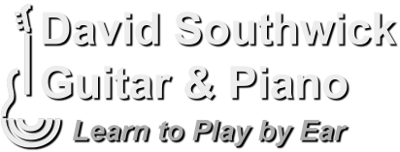Basic Chord Theory
What Am I Playing on the Guitar?Strings and Frets
It might be helpful to first identify the strings on the guitar. Look at the picture below.

A couple of observations from the above graphic include:
- The string names E, A, D, G, B, E. These strings in this order are named from lowest pitch to highest pitch. We also refer to the strings by numbers. However, we start with the “top-pitched” note, thus the high E is number 1, the B is number 2, etc. Sometimes we see them written this way: E1, B2, G3, D4, A5, E6. We call E1 the “top” string, and E6 the “bottom” string.
- Each fret represents a half-step interval. When E6 is fretted on the 1st fret, the note played is a half-step up from E: the F note. The note played on E6 on the 3rd fret is G. The note played on B2 on the 3rd fret is D. This is especially important when we incorporate chord formulas to modify an existing chord.
Applying Chord Formulas
Once you know the strings and the half-step intervals of frets, you can begin to apply chord formulas to standard chords. When you see the chord G2, you can take your normal G chord and modify it. The G chord is G,B,D (according to the formula 1,3,5). The G2 uses the chord formula: 1,2,5. There is no 3rd note, so we drop the 3rd note (B) of the G chord and include the 2nd note (A). Thus we need G,A,D.
Let’s look at a typical G chord:

I’ve included the notes being played by each string. We could open the A5 string to drop the B and gain an A note. However, when modifying chords we generally do not want to add our ‘new’ note on either of the the lower two strings. So we will mute the A5 string to drop the ‘B’ and we will move our ‘1’ finger to the G3 string in the second fret. This will take that G note up a whole step to an A. Here is how the diagram would look:
There you have it. A perfect G2 chord! Following this procedure we can modify many of the chord shapes we already know. Sometimes, however, we may need to start from a different chord shape. At times barre chords can help us here. Other times, we may need to invent a whole new chord from scratch. Or we could just Google it, but what would be the challenge of that?
Types of Chord Charts

Figure 4 demonstrates how we would show the Am chord using tablature, or simply, TAB. The top line represents the top string, or E1. This chart says that E1 is played open, B2 is played on the first fret, G3 is played on the second fret, etc. There is no number on E6 meaning the string is not played. Because these numbers are ‘stacked’, we know they are played simultaneously (or strummed). For more information on how to read TAB, click here.






PS. missing left hand index finger.
regards Rob
Hi, As I play guitar (right handed)with a missing index finger and play fingerstyle I have always played by ear and made my own tunes (not bad) as reading always got frustrating for the lack of a finger. the problem with not reading is most of my tunes work off one scale/key and I need to know how to move to other keys/scales.
If you can advise I would appreaciate it. I have found your site most helpfull.
Thank you, Rob
I do not know if it’s just me or if everyone else encountering issues with your blog. It appears as if some of the written text within your posts are running off the screen. Can somebody else please provide feedback and let me know if this is happening to them too? This could be a issue with my browser because I’ve had this
happen previously. Appreciate it
Well, I don’t recall seeing an E1 anywhere, but an E2 is a shortened form of Esus2, which if you look at the E major scale ( E F# G# A B C# D# E), and number these notes 1-8, and then take notes 1,2 and 5 which are E, F#, and B. The way you would play this particular chord is 022200.
Where you might see an E1 is on a set of guitar strings where they are labeled by their string name and number: E1 B2 G3 D4 A5 E6.
can you please show me what is meant for E1 and E2?
thanks
Isabella
Thanks, Let me know if you have any questions about this material.
Good explanation! I had not heard of G2 before but was shown this chord on a the song Go Rest HIgh Upon That Mountain by Vince Gill. Needed to learn it quick . . . easy explanation here. Thanks!